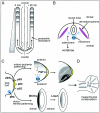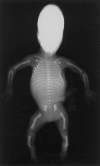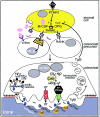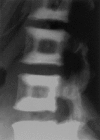Genetic disorders of the skeleton: a developmental approach
- PMID: 12900795
- PMCID: PMC1180673
- DOI: 10.1086/377110
Genetic disorders of the skeleton: a developmental approach
Abstract
Although disorders of the skeleton are individually rare, they are of clinical relevance because of their overall frequency. Many attempts have been made in the past to identify disease groups in order to facilitate diagnosis and to draw conclusions about possible underlying pathomechanisms. Traditionally, skeletal disorders have been subdivided into dysostoses, defined as malformations of individual bones or groups of bones, and osteochondrodysplasias, defined as developmental disorders of chondro-osseous tissue. In light of the recent advances in molecular genetics, however, many phenotypically similar skeletal diseases comprising the classical categories turned out not to be based on defects in common genes or physiological pathways. In this article, we present a classification based on a combination of molecular pathology and embryology, taking into account the importance of development for the understanding of bone diseases.
Figures






References
Electronic-Database Information
-
- Health Supervision for Children with Achondroplasia, American Academy of Pediatrics, http://www.aap.org/policy/00696.html - PubMed
-
- Online Mendelian Inheritance in Man (OMIM), http://www.ncbi.nlm.nih.gov/Omim/ (for postaxial polydactyly type I, preaxial polydactyly type IV, Greig cephalopolysyndactyly, dominant Pallister-Hall syndrome, TBS, TPTPS, EEC, limb-mammary syndrome, nonsyndromic SHFM, Hay-Wells syndrome, SHFM1, HOS, Okihiro syndrome, ulnar-mammary syndrome, acheiropodia, NPS, SPD, hand-foot-genital syndrome, amegakaryocytic thrombocytopenia and radioulnar synostosis, BDA1, BDB, BDC, chondrodysplasia [Grebe type], chondrodysplasia [Hunter-Thompson type], Du Pan syndrome, proximal symphalangism, multiple-synostosis syndrome, campomelic dysplasia, Ellis–van Creveld syndrome, CCD, LWD, Langer mesomelic dysplasia, multiple cartilaginous exostoses, tricho-rhino-phalangeal syndrome, Blomstrand chondrodysplasia, Jansen type metaphyseal chondrodysplasia, enchondromatosis, achondroplasia, hypochondroplasia, thanatophoric dysplasia, autosomal dominant hypophosphatemic rickets, recessive Robinow syndrome, achondrogenesis type II, hypochondrogenesis, SEDc, Kniest dysplasia, Stickler dysplasia, otospondylomegaepiphyseal dysplasia, EDM2, EDM3, EDM1, pseudoachondroplasia, EDM5, EDM4, diastrophic dysplasia, atelosteogenesis type 2, achondrogenesis type 1B, dyssegmental dysplasia [Silverman-Handmaker type], Schwartz-Jampel syndrome, hypophosphatasia, CMD, OPS, HBM, ADOI, sclerosteosis, van Buchem disease, juvenile Paget disease, familial expansile osteolysis, Camurati-Engelmann syndrome, idiopathic osteolysis, ARO, osteopetrosis with renal tubular acidosis, ADOII, and pycnodysostosis)
References
-
- ADHR Consortium, The (2000) Autosomal dominant hypophosphataemic rickets is associated with mutations in FGF23. Nat Genet 26:345–348 - PubMed
-
- Afzal AR, Rajab A, Fenske CD, Oldridge M, Elanko N, Ternes-Pereira E, Tuysuz B, Murday VA, Patton MA, Wilkie AO, Jeffery S (2000) Recessive Robinow syndrome, allelic to dominant brachydactyly type B, is caused by mutation of ROR2. Nat Genet 25:419–422 - PubMed
-
- Albrecht AN, Schwabe GC, Stricker S, Boddrich A, Wanker EE, Mundlos S (2002) The synpolydactyly homolog (spdh) mutation in the mouse—a defect in patterning and growth of limb cartilage elements. Mech Dev 112:53–67 - PubMed
-
- Arikawa-Hirasawa E, Watanabe H, Takami H, Hassell JR, Yamada Y (1999) Perlecan is essential for cartilage and cephalic development. Nat Genet 23:354–358 - PubMed
Publication types
MeSH terms
LinkOut - more resources
Full Text Sources
Other Literature Sources
Miscellaneous

